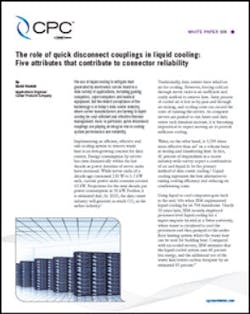The use of liquid cooling to mitigate heat generated by electronics can be found in a wide variety of applications, including gaming computers, supercomputers and medical equipment.
But the widest acceptance of the technology is in today’s data center industry, where server manufacturers are turning to liquid cooling for cost-efficient and effective thermal management. Here, in particular, quick disconnect couplings are playing an integral role in cooling system performance and reliability.
Implementing an efficient, effective and safe cooling system to remove waste heat is an ever-growing concern for data centers. Energy consumption by servers has risen dramatically within the last decade as power densities of server racks have increased.
While server racks of a decade ago consumed 250 W to 1.5 kW each, current power racks consume around 10 kW. Projections for the next decade put power consumption at 50 kW. In fact, IBM recently employed processor-level liquid cooling for a supercomputer located at a Swiss university, where water is circulated to cool the processors and then pumped to the under-floor heating system where the waste heat can be used for building heat.
Download the new report, courtesy of CPC, “The Role of Quick Disconnect Couplings in Liquid Cooling: Five Attributes that Contribute to Connector Reliability,” that explores the role of quick disconnect couplings in liquid cooling.
